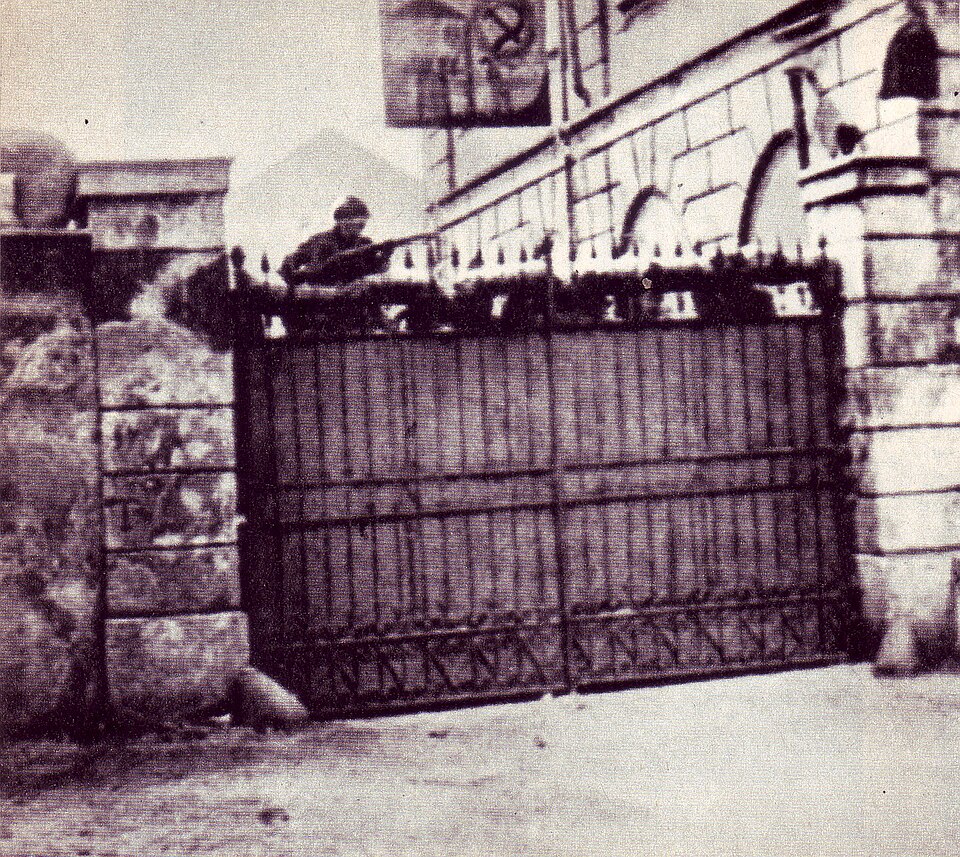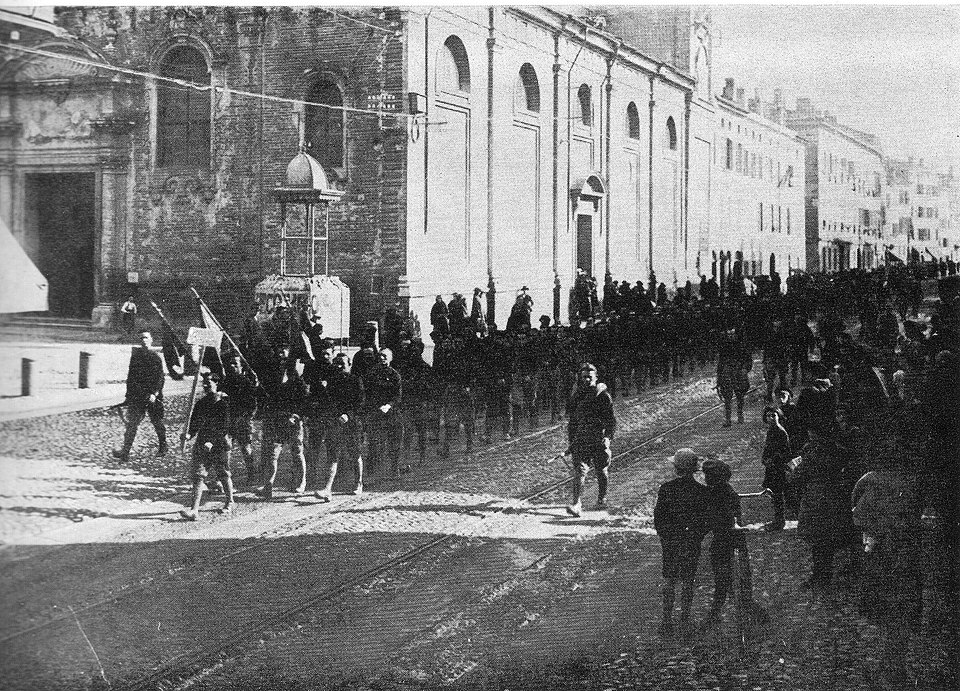OCR Specification focus:
‘post-war problems including economic problems, industrial and agrarian unrest, political instability; the career of Mussolini; the ideas, appeal and support of Fascism.’
Italy emerged from the First World War deeply divided, economically fragile, and politically unstable. These conditions shaped the rise of Mussolini and facilitated the success of Fascism.
Post-War Problems
Economic Disruption
The war left Italy in a precarious economic state:
High Inflation: The cost of living soared, eroding wages and savings.
War Debt: The Italian government had borrowed heavily, leading to dependence on foreign creditors.
Unemployment: Millions of demobilised soldiers returned to few opportunities.
Collapse of industry: Wartime production had not translated into sustainable peacetime growth.
This economic strain undermined confidence in liberal governments and opened space for radical alternatives.
Industrial Unrest
Between 1919 and 1920, Italy entered the Biennio Rosso (Two Red Years).
Waves of strikes, factory occupations, and clashes paralysed cities.
Trade unions and socialist councils inspired by the Russian Revolution demanded change.
Employers feared a communist-style revolution and looked for political protection.
The industrial unrest highlighted the weakness of the liberal state and contributed to the appeal of strong authoritarian solutions.
Industrial and agrarian unrest culminated in the Biennio Rosso of 1919–1920, including mass strikes and factory occupations.

Workers occupying a Milan factory during September 1920, a peak moment of the Biennio Rosso. The photograph exemplifies mass action, self-management, and the paralysis of production that destabilised liberal governments. It contextualises why elites and middle-class groups turned toward Fascist ‘order’. Source
Agrarian Unrest
Rural Italy also experienced upheaval:
Land seizures: Returning soldiers and peasants occupied estates.
Tenant demands: Farmworkers pressed for shorter hours and better pay.
Landowners and the Catholic Church feared that socialism threatened traditional hierarchies.
The inability of successive governments to manage unrest deepened political instability.
Political Instability
The Italian political system, rooted in Trasformismo (DEFINITION below), was poorly equipped to handle post-war crises.
Trasformismo: A system of flexible coalitions and compromises among politicians, which prevented strong, stable governments and fostered corruption.
Fragmented parties produced fragile coalition governments.
The ‘Mutilated Victory’ narrative – disappointment with the Paris Peace Settlement – fuelled nationalist anger.
Gabriele d’Annunzio’s seizure of Fiume in 1919 exposed the state’s weakness and demonstrated the power of direct action.
These conditions made Italian politics increasingly volatile.
The Career of Mussolini
Early Life and Political Shift
Initially a socialist, Mussolini edited Avanti!, the socialist newspaper.
Expelled in 1914 for supporting intervention in the war, he founded Il Popolo d’Italia.
His shift from socialism to nationalism was crucial in forming the ideological base of Fascism.
Mussolini’s founding of Il Popolo d’Italia provided a political and fundraising platform that tied veterans, nationalists and business allies to the Fasci di Combattimento.
Foundation of Fascism
In March 1919, Mussolini established the Fasci di Combattimento in Milan.
The early programme was radical and republican.
Electoral performance was weak in 1919, but violence and agitation soon brought attention.
By 1921, Mussolini repositioned Fascism to attract conservative support, dropping anti-clericalism and emphasising order.
Political Breakthrough
The Electoral Pact of 1921 with Giolitti gave Fascists a foothold in parliament.
Mussolini skilfully balanced between radicals and moderates, presenting himself as indispensable to restoring order.
By 1922, he was well-placed to seize power through the March on Rome.
Fascist squadristi used organised violence and intimidation, often abetted by landowners and industrialists, to break strikes and erode socialist control in the provinces.

Blackshirt squads transiting to Parma during the barricades of Parma, August 1922. The image captures the disciplined, militarised aesthetic central to Fascism’s appeal and support, and its readiness to confront left-wing organisations. Although taken in 1922, it exemplifies the escalation of squad violence rooted in the post-war crisis. Source
The Ideas of Fascism
Core Principles
Fascism was not a fully developed ideology but drew upon diverse influences:
Nationalism: A call for unity, strength, and expansion.
Anti-socialism and anti-liberalism: Opposition to parliamentary democracy and Marxism.
Authoritarianism: Emphasis on discipline, hierarchy, and leadership.
Violence: Acceptance of force as a legitimate political tool.
Definition of Fascism
Fascism: A nationalist, anti-liberal, and anti-socialist movement advocating authoritarian leadership, the suppression of opposition, and the use of violence to achieve political ends.
Unlike socialism, Fascism offered no coherent economic theory, but it promised order and national revival, appealing to multiple classes.
The Appeal of Fascism
To Elites
Landowners saw Fascists as defenders against socialism.
Industrialists funded Fascist squads to break strikes.
The Catholic Church warmed to Mussolini’s abandonment of anti-clerical policies.
To the Middle Classes
Fear of communism drove shopkeepers, professionals, and clerks towards Fascism.
Fascist rhetoric of patriotism and discipline resonated with those frustrated by instability.
To Ex-Soldiers and Youth
Veterans’ organisations linked with Fascism through promises of glory and national rebirth.
Young men found in Fascist squads a sense of purpose and belonging.
To the General Public
Fascists cultivated the image of Mussolini as a dynamic leader capable of decisive action.
The failure of liberal governments to solve unrest enhanced Mussolini’s credibility.
Support Base of Fascism
By the early 1920s, Mussolini’s support base was broad:
Landowners and industrialists provided financial backing.
Middle classes provided electoral weight.
Disillusioned workers and veterans swelled the ranks of the movement.
The monarchy and military elites saw Mussolini as a safeguard against revolution.
This coalition enabled Fascism to move from a marginal group in 1919 to a dominant force by 1922, ready to exploit Italy’s fragile democracy.
FAQ
Demobilised soldiers returned in their millions, often without employment or pensions. Many felt betrayed by the government for failing to deliver on promises of land and recognition.
Some joined socialist protests demanding reform, while others, particularly disgruntled veterans, gravitated towards Fascist squads, seeing them as a continuation of military camaraderie. Their frustration fuelled both unrest and the militarisation of politics.
The term referred to Italy’s disappointment after the Paris Peace Settlement, where Italy gained Trentino-Alto Adige and Istria but not Dalmatia, Fiume, or Dalmatians promised under the Treaty of London.
This sense of betrayal was exploited by nationalists and Mussolini, who argued that Italy’s sacrifices in war had been dishonoured. It discredited liberal leaders as weak in defending national interests.
The event demonstrated the weakness of the Italian state, as the government failed to act decisively for over a year.
For Mussolini, it showed the power of nationalist symbolism and direct action. Fascists later imitated this theatrical style of politics, with marches, uniforms, and choreographed violence that appealed to patriotic emotions.
The Biennio Rosso saw:
Widespread strikes and factory occupations.
Peasant land seizures in rural areas.
Socialist councils inspired by Russia.
To the middle classes, this looked like the start of a Bolshevik-style revolution. Fear of losing property and status pushed many towards supporting Fascism as a force to restore order.
Originally, the 1919 Fascist programme included republicanism, land reform, and anti-clericalism, which limited appeal to conservatives.
By 1921, Mussolini dropped anti-clerical elements, emphasised patriotism, and aligned with elites by defending property rights. This pragmatic shift helped secure support from industrialists, landowners, and the Catholic Church, transforming Fascism from fringe radicalism into a broad-based movement.
Practice Questions
Question 1 (2 marks)
Name two problems faced by Italy in the immediate aftermath of the First World War (1919–1920).
Mark Scheme
1 mark for each correct problem identified (maximum 2).
Acceptable answers include:
High inflation / rising cost of living
Heavy war debt
Mass unemployment and demobilisation issues
Industrial strikes and factory occupations (Biennio Rosso)
Agrarian unrest / land seizures
Political instability / weak coalition governments
Disappointment over the Paris Peace Settlement / “Mutilated Victory”
Question 2 (6 marks)
Explain how Mussolini’s use of propaganda and violence helped increase Fascist support between 1919 and 1922.
Mark Scheme
Level 1 (1–2 marks): Limited knowledge, general statements with little explanation. May refer vaguely to Mussolini or Fascists without clear detail.
Level 2 (3–4 marks): Some accurate knowledge shown. Explains one factor (propaganda or violence) but not both, or explanation lacks depth. For example, mentioning Il Popolo d’Italia but not how it spread nationalist ideas, or describing squadristi without showing how they weakened socialist opposition.
Level 3 (5–6 marks): Clear and developed explanation of both propaganda and violence. Specific examples used to show how each increased support. For example:
Propaganda: Mussolini’s newspaper Il Popolo d’Italia promoted nationalism and presented Fascism as a force for order. Mussolini portrayed himself as a dynamic leader capable of restoring stability.
Violence: Fascist squadristi attacked socialists, broke strikes, and reassured industrialists and landowners by undermining left-wing movements. Violence created the perception that Fascists could restore order where the government had failed.
Award top marks for answers that balance both aspects and link them explicitly to increased Fascist appeal.

